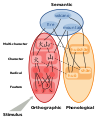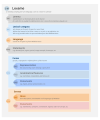User:Yug/Sources Language Acquisitions
To-do list is empty: remove {{To do}} tag or click on edit to add an item. |
Keywords
Second language learning (SLA), Computer-assisted language learning, vocabulary acquisition research, cycle, e-learning, attitude, Piaget, Four stages of competence, Stephen Krashen, Acquisition-learning hypothesis, Language learning, Language Learning Strategy (LLS), Vocabulary Learning Strategies (VLS), Rote_learning (=repetition), Augmented learning (=e-learning with data mining)Bloom theory, Natural Language processing (NLP), Computer-assisted language learning (CALL).
Vocabulary acquisition
- Downloaded
 Done
Done
|
- 2⁄4 Sciencedirect.com
- Group A NOT DONE
- Oxford, Rebecca L.; Scarcella, Robin C. (1994), "Second language vocabulary learning among adults: State of the art in previous vocabulary instruction (abstract)", System, vol. 22, no. 2, pp. 231–243,
- Atkinson, Richard C. (1972), "Optimizing the learning of a second-language vocabulary (abstract)", Journal of Experimental Psychology, vol. 96, pp. 124–129, )
- Moulin, André (1984), "The problem of vocabulary teaching: An answer to Robbins Burling (abstract)", vol. 12, pp. 147–149 http://www.sciencedirect.com/science?_ob=ArticleURL&_udi=B6VCH-466FG4F-6X&_user=10&_coverDate=12%2F31%2F1984&_alid=1431494130&_rdoc=8&_fmt=high&_orig=search&_cdi=5955&_sort=r&_st=4&_docanchor=&_ct=6018&_acct=C000050221&_version=1&_urlVersion=0&_userid=10&md5=1f6f6ab87efff571bb86bf80286cecc8
{{citation}}: Missing or empty|title=(help)
- Group B
- Arnfast, J.S.; Jørgensen, J.N.; Holmen, A. (2010), Second Language Learning (abstract), International Encyclopedia of Education, pp. 419–425
- Levin, Joel R.; Carney, Russell N.; Pressley, Michael (1988), Facilitating vocabulary inferring through root-word instruction (abstract), vol. 13, Contemporary Educational Psychology, pp. 316–322
{{citation}}: Unknown parameter|month=ignored (help)
- Paivio, Allan; Desrochers, Alain (1981), Mnemonic techniques in second-language learning (abstract), vol. 73, Journal of Educational Psychology, pp. 780–795
{{citation}}: Unknown parameter|month=ignored (help)
- Sagepub.com (not check elsewhere)
- 1⁄4 Laufer, Batia; Shmueli, Karen (1997), Memorizing New Words: Does Teaching Have Anything To Do With It? (abstract), vol. 28, RELC Journal, pp. 89–108, )
- 1⁄4 Nation, I.S.P. (1982), Beginning to Learn Foreign Vocabulary: A Review of the Research (abstract), vol. 13, RELC Journal, pp. 14–36, )
- 1⁄4 Schmitt, Norbert (2008), Review article: Instructed second language vocabulary learning (abstract), vol. 12, Language Teaching Research, pp. 329–363, S2CID 145583019
- 1⁄4 Gbook
- McKeown, Margaret G.; Curtis, Mary E. (1987), The Nature of vocabulary acquisition (partial preview), p. 192, )
- p89: Sternberg, "most vocabulary is learned from context"
- Coady, James; Huckin, Thomas N. (1997), Second language vocabulary acquisition: a rationale for pedagogy (partial preview), Cambridge University Press, p. 299, )
- Hunt, Alan; Beglar, David (8 April 2002), Current Research and Practice in Teaching Vocabulary (partial preview), Cambridge University Press, pp. 255–272, ISBN 9780521004404
- From: Richards, Jack C.; Renandya, Willy A. (2002), Methodology in language teaching: an anthology of current practice, Cambridge University Press, pp. 402(255-272), )
- Nation, I.S.P. (2001), Learning Vocabulary in Another Language (partial preview), Cambridge University Press, pp. 6–22, ISBN 0521804981 (First chapter)
- Gass, Susan M.; Selinker, Larry (2001), Second language acquisition: an introductory course (partial preview), Topics in Applied Psycholinguistics Series, Routledge, p. 488, )
- Gass & Selinker, 2001: Outline - SLA Glossary
- Schmitt, N; McCarthy, M (1997), Vocabulary: Description, Acquisition and Pedagogy (partial preview), Cambridge University Press, p. 383, )
- Schmitt & McCarthy, 1997 : First chapter - Vocabulaire acquisition's Glossary
- Laufer, B. (1997), "What's in a word that makes it hard or easy? Some intralexical factors that affect the learning of words", in Schmitt, M.; McCarthy, M (eds.), Vocabulary: Description, Acquisition and Pedagogy, Cambridge: Cambridge University Press, pp. 140–155
- Schmitt, N. (1997), "Vocabulary learning strategies", in Schmitt, M.; McCarthy, M (eds.), Vocabulary: Description, Acquisition and Pedagogy, Cambridge: Cambridge University Press, pp. 199–227
- Boers, Frank; Lindstromberg, Seth (2009), Optimizing A Lexical Approach to Instructed Second Language Acquisition (cover only), p. 240, )
- Eric's
- Ellis, Rod (1991), The Interaction Hypothesis A critical evaluation (abstract), p. 37 (Abstract) - on Michael H. Long's Interaction Hypothesis
- Gu, Yongqi; Johnson, Robert Keith (1996), "Vocabulary Learning Strategies and Language Learning Outcomes (abstract)", Language Learning; A Quarterly of Applied Linguistics, vol.46 n⁰4, Language Learning: 643–79, )
- Jstor.org
- (used) Krashen, S.D. (1989), "We acquire vocabulary and spelling by reading: additional evidence for the input hypothesis (abstract)", The Modern Language Journal, Modem Language Journal, vol.73, n⁰4 (4): 440–464, )
- (used) Krashen, S.D.; Seliger, H.W. (1975), The Essential Contributions of Formal Instruction in Adult Second Language Learning (abstract), TESOL Quarterly, vol. 9, Teachers of English to Speakers of Other Languages, Inc. (TESOL), pp. 173–183, JSTOR 3585484
- 1⁄4Somewhere else
- Schmitt, Norbert (2000), Vocabulary in Language teaching, Cambridge University Press, ISBN 0521669383 (First chapter)
- (Ellis, 1991) on Long's works :
- Long, 1990: the Negotiation of meaning has been shown to contribute greatly to the acquisition of vocabulary;
- Negotiation of a word/lexical unit: The Negotiation of meaning has been shown to contribute greatly to the acquisition of vocabulary (Long, 1990)
- Generative use of words: the use of words in new contexts which stimulate a deeper understanding of their meaning.
Unsecure
- To search again
- Read, John (2004), "7. Research in Teaching Vocabulary", Annual Review of Applied Linguistics, 24: 146–161, S2CID 61492519
- Nation, I.S.P. (2005), "Teaching and learning vocabulary", in Hinkel, E. (ed.), Handbook of Research in SecondLanguage Teaching and Learning, Lawrence Erlbaum Associates, NJ, pp. 581–595
- Not found WP/Gl/GlS/ScD.
- Institut Supérieur des Langues Vivantes (I.S.L.V.), Université de Liège, Belgium
- Dale, E. & O'Rourke, J., 1986, Vocabulary building. Columbus, OH: Zaner-Bloser.
- Citations to search again
|
Statement:
|
|
Statement:
|
- Tool approach
Whatever the context (stand alone ; example sentence ; short context ; in text), words glossed in the learner's L1 are always better retention scores compare than those glossed in L2. (Laufer & Shmuli, 1997) Words presented in lists and in sentences were remembered better than words presented in text and elaborated text. (Laufer & Shmuli, 1997) We can conclude to statements supporting our view: 1. lexicon's list such dictionaries are a good tools for vocabulary acquisition. 2. bilingual approach (definition in L1) is better for vocabulary acquisition.
- Zone proximale de développement Zone of proximal development
- fr:Apprentissage#Tableau_des_th.C3.A9ories_d.27apprentissage
- Epistemology#Acquiring_knowledge
- Second_language_acquisition & Language_acquisition#Vocabulary_acquisition
- Glossary of language teaching terms and ideas
- List_of_language_acquisition_researchers > Stephen Krashen
Krashen oriented
|
Statement: Learning VS learning opportunities
|
|
Statements: 1. Vocabulary is critical in SLA (perceive importance Voc>Grammar); 2. Acquirers complain limited vocabulary = major problem.
|
|
Statements: 1. Isolation of lexical items is critical 2. Checking tool. 3. Increases in SL [VocA] proficiency = provide easier access to those aspects.
|
|
Statement: Comprehensive input hypothesis = LA (LangA)/VA (VocA) takes place only when learners receive input slightly beyond their current level of L2 competence, “i+1.”
|
Lexicology & Lexicography (Chinese ~)
-
Chinese character example, made by 3 dimensions: ① 火 (grapheme) ; ② huo3 (phoneme) ; ③ fire (seme). Inassociatethem together.
- Linguistics: scientific study of natural language.
- Lexicology: study of words, their nature and meaning, words' elements, relations between words (semantical relations), word groups and the whole lexicon.
- Lexicography: creating dictionaries based on Lexicology's concepts.
- Lexical semantics: study of how and what the words of a language denote/symbolyse (Pustejovsky, 1995). mapping of words to concepts in a Semantic net.
- Semantic net: net of words lexical units linked by Lexical relations like synonymy, antonymy, hyponymy and hypernymy - and to a certain degree homonymy
- Genus-differentiæ : definite a word as a precision of a general and know concept (stare: look fixedly... at someone/something)
Terms of lexicology:
- Lexicon: complete vocabulary of a language, with words and expressions.
- Idiolect: language unique to an individual. Ex: /le frère !/
- Glossary/idioticon/vocabulary/clavis: alphabetical list of terms in a particular domain of knowledge with the glosse/definitions for those terms. Usually ending a chapter/book.
- Glosse : brief notation of the meaning of a lexical unit of a text.
- Lexemes: list of variations of a word, such: Run (run, runs, ran, ...)
- Lemma: the canonical form of the lemme's list > RUN
- Chereme(Greek: "hand") : basic unit of signed communication. Ex: pointing with a finger
- ?Word: common definition of a lexical unit loosely definite as a succession of graphemes having a semantic value and bordered by two space.
- 中文詞語:由兩個或多個單字所組成,持有獨立的意思
- Lexical entry/items/unit: are a single word or chain of words that are the basic elements of a language's lexicon (vocabulary).
- * ?Lexis: one meaning of a lexical entry ?
- Utterance (speech): a complete unit of speech in spoken language, generally but not always bounded by silences.
- Vocable (speech): an utterance, term, or word that is capable of being spoken and recognized.
- Morpheme : smallest linguistic unit that has semantic meaning. Ex: im|possible, 2 morphemes.
- Grapheme : smallest unit in a written language. ex: /bag/, 3 graphemes ; but /a/ = /ɑ/ = 2 glyphs = 1 grapheme.
- Glyphs: existing variation of a grapheme.
- Phoneme : smallest segmental unit of sound employed to form distinctive words. Ex: /p/, /k/, etc."box" = 3 graphemes, but 4 phonemes: /ˈbɒks/.
- ?Sememe : smallest semantic language unit of meaning, correlative to a morpheme. Ex: im(negation) |possible (can be done), 2 sememes
- ?Seme: smallest unit of meaning recognized in semantics. existing variation of a sememe.
Papers:
- Sciencedirect.com: 2006, Chinese Lexicography, Encyclopedia of Language & Linguistics, Pages 362-365
- CAO Wei (College of Humanities, Shueparchy University, Jiangshu215021);The Definition of Heterograph and the Difference between Heterograph and Synonym[J];Chinese Language Learning;2004-01
The discrepancies of word in phonetics, morphology, [grammar] and semantics determine the differences that the word expresses in its quality and effect. (CAO Wei, 2004)
- Packard, [http://www.ealc.uiuc.edu/ealc/people/faculty/packard.htm Jerome] (2000), "Chinese words and the lexicon." The Morphology of Chinese: A Linguistic and Cognitive Approach (partial preview), Cambridge University Press, pp. 284–309
{{citation}}: External link in|first1= - Abun-Nasr, Jamil M.; F (1985), Chinese Lexicology & Lexicography, The Chinese University Press, p. 408, )
{{citation|first1=|last1=F|title=|year=|publisher=|pages=|isbn=|url=}}
Memory: memorization cycle & memorization´s cost
- Bloom taxonomy: Bloom's Taxonomy of Educational Objectives
- Learning Cycle : http://www.agpa.uakron.edu/p16/btp.php?id=learning-cycle
- Language Learning & Technology: http://llt.msu.edu/default.html
- Stages of Second Language Acquisition www.everythingesl.net/inservices/language_stages.php
- Frayer Model (Word Categorization) : Def ; MyDef ; Specifics ; Examples ; Non-examples.
- What is learning: http://km4meu.wordpress.com/category/learning/
- Recall_(memory)#Factors_that_Affect_Recall
| Me | Encoding (Memory) |
|---|---|
|
|
Computing
- Computing
- Groot, Peter J.M. (2000), "Computer Assisted Second Language Vocabulary Acquisition", Language Learning & Technology, vol. vol.4 n⁰1, pp. 60–81
{{citation}}:|volume=has extra text (help); Unknown parameter|month=ignored (help)
Questions about Memorization cost
Hello Looie,
I currently read articles about memory for my master thesis (Vocabulary acquisition and Chinese lexicon), and I'm particularly interested by
- Associative learning/memory: I read somewhere that "learning goes is easier when based on previous knowledge".
- What is new vocabulary/lexical unit is the memory processing(encoding/storage) of its constituents, namely new graphemes set, new phonemes set, and new seme such ① grand-parent (as new-unknow combination of graphemes) / ② ɡʁɑ̃.pa.ʁɑ̃ (new combination of phonemes) / ③ parents of someone's parents (new semes) and associating/grouping ① ② ③ altogether, in order to recall this lexical unit later".
- harder that learning an association (all english : ① grand-parent (grand + parent = know↔know) ↔ ③ parents of someone's parents (new combination)







